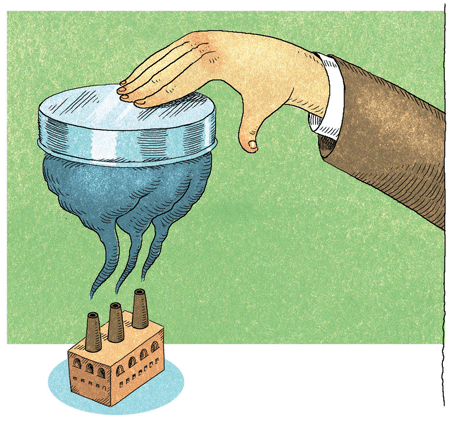Cap-and-trade is the most efficient system to reduce carbon emissions. None of the principal alternatives—neither a system of regulatory commands that mandates emission reductions nor a carbon tax—are as efficient in practice, even though they could be made so in theory.
For instance, regulatory mandates would be efficient if an all-knowing government regulator could prescribe rules capable of making the cost of reducing an additional unit of emissions equal among all participants, the essential condition for efficiency. But since the regulator will never be able to know the possibilities of all different plants or factories for reducing emission and their costs, this approach is inefficient.
A carbon tax might appear to offer more promise. It would set a single price and provide an identical incentive for the incremental reductions of carbon emissions. A fundamental principle of economics is that prices and quantities are “dual,” that is, they are different manifestations of the same underlying phenomenon. Thus, a tax (a fixed price) could be designed to mimic a cap (a fixed quantity), and vice versa. But this theoretical equivalence ignores practical realities. The most important of these is dealing with concerns of fairness that are associated with any regulatory or legislative action. Unfortunately, under a carbon tax, fairness would be handled by establishing differing tax rates, which create different prices and the unequal incentives to reduce emissions that make this option less efficient than what theory would suggest.
The advantage of a cap-and-trade program is that it is able to deal with the question of fairness through the free allocation of the allowances (or tradable rights to emit) that must be surrendered against emissions. Free allowances enable the emitter to comply up to the amount of the free allocation without incurring an out-of-pocket cost. However, an opportunity cost is incurred since an allowance surrendered is an allowance that can’t be sold. This opportunity cost—being able to sell an allowance in the market, say for $10—provides exactly the same incentive as having to purchase an allowance. In both cases, it pays to reduce emissions costing less than $10 per unit of emissions reduction. Herein lies the (imperfect) beauty of cap-and-trade: the question of fairness (and the politics that come with it) is dealt with in a way that maintains a single price and an equal incentive to reduce emissions that does not detract from efficiency.
A tax system could achieve the same results by settling competing claims of emitters through financial compensation from tax revenues. In practice, though, claimants are more likely to argue for tax reductions, on the rational assumption that they are less subject to later revision. This bias toward tax breaks instead of revenue grants of equivalent value is inconvenient, but it is the practical reality that makes cap-and-trade more efficient than a tax.
Setting aside the issue of how the question of fairness is handled—the main reason for preferring cap-and-trade—there is a general sense that cap-and-trade is inefficient based on three arguments, none of which apply in practice.
The first of these focuses on the process of free allocation by which allowances are usually distributed. By its very nature the process of distributing free allowances seems to be so fraught with politics that most assume it has to be inefficient. And it’s true perhaps, especially compared with some ideal in which fairness can be taken for granted. But then, all legislative and regulatory processes when viewed up close—not least those involving taxes—are highly political and imperfect. The problem is not the concessions that are made, which are an inevitable part of passing laws in a democratic society, but the form they take, the effects on price and the incentives they create to reduce emissions.
A second argument for the inefficiency of cap-and-trade concerns the overall costs to society, or the effect on welfare of the choice of a price or quantity constraint when the future turns out to be different from what was expected. A tax fixes the price and lets the quantity vary, while cap-and-trade fixes the quantity and lets the price vary. Both can be made equivalent, but the question becomes how the inevitable later deviations from expectation affect the general welfare. The answer depends on the particular environmental problem being addressed.
For long-lasting greenhouse gases, the overall cost to society is less if the price is fixed and quantities allowed to vary (a tax) than the opposite (cap-and-trade). While this theoretical insight is correct, it has yet to gain any traction in the real world of environmental legislation and regulation.
A third argument is that a government auction of allowances could provide revenue that it could use to reduce taxes, which would in turn encourage more work and investment that could also help pay the cost of reducing emissions. Unfortunately, auctioning does not guarantee a reduction in taxes. Virtually all of the many present proposals to auction allowances envisage using auction revenue for other purposes, which may be worthy but which elicit no additional work or investment. Again, this is a matter of practical reality, not theoretical possibility.
In the end, cap-and-trade is the most efficient and practical system to reduce carbon emissions because it is the only alternative that can deal with fairness (equity) without detracting from efficiency. Or, to paraphrase Winston Churchill’s famous quip about democracy, cap-and-trade is the least efficient form of regulation except for all the others that have been tried.




